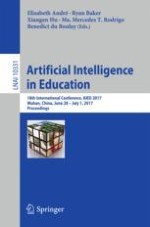This book constitutes the refereed proceedings of the 18th International Conference on Artificial Intelligence in Education, AIED 2017, held in Wuhan, China, in June/July 2017. The 36 revised full papers presented together with 4 keynotes, 37 poster, presentations, 4 doctoral consortium papers, 5 industry papers, 4 workshop abstracts, and 2 tutorial abstracts were carefully reviewed and selected from 159 submissions. The conference provides opportunities for the cross-fertilization of approaches, techniques and ideas from the many fields that comprise AIED, including computer science, cognitive and learning sciences, education, game design, psychology, sociology, linguistics as well as many domain-specific areas.
